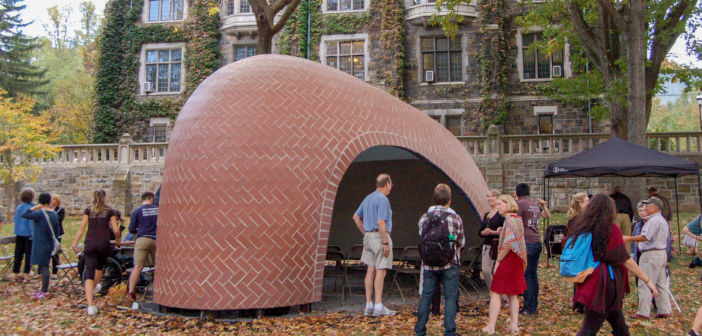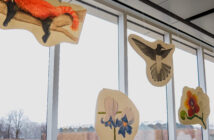Lehigh students might have noticed something different about the Sacred Grove, the wooded area between Packard Lab and the Alumni Memorial Building, upon their arrival on campus for the fall semester. That’s because the space no longer houses Peggie’s Bell, the seven-ton acoustic shell that was designed and constructed by faculty and students in fall 2015.
Can Zabci, ’16, was shocked when, on one of the first days of classes this semester, a friend sent him a picture of the Sacred Grove without the bell. Zabci, who had studied architecture at Lehigh, was one of the students who worked on the bell.
Zabci said he and other students who helped create the bell were not aware that it was going to be demolished. Zabci expressed his shock in an Instagram post in which he asked the university why the bell was demolished and why students were not warned of its demolition. Zabci said he also messaged President Simon on Instagram, but he doesn’t think Simon has seen the message.
“I shouldn’t have to hear about (the demolished bell) from a friend that goes to Lehigh, but (rather from) the people who decided to take it down,” Zabci said.
Architecture professor Anthony Viscardi, who led the design and construction of the bell, said Zabci epitomized the way a lot of students felt about the removal.
Lori Friedman, Lehigh’s director of media relations, said Peggie’s Bell was planned as a one-year temporary installation and was granted a one-year extension.
Though the structure was planned as a temporary installment, Viscardi said the bell felt increasingly permanent to members of the design and construction team as they worked on it.
“As things developed, it started to become more permanent in our minds and more permanent in terms of how we designed it for the grove, but it still was effectively a temporary structure,” Viscardi said. “I think perhaps I, or the university, but probably more me, should have contacted the students before it came down.”
Peggie’s Bell was a project funded by the Hammerschlag Design Series. HDS emphasizes experiential learning — particularly design and building experience — for the department of art, architecture and design.
Zabci said Peggie’s Bell was the biggest project in the series because it was the most costly, the most time consuming and involved the most people. The bell’s construction process lasted longer than anticipated, amassing to about four months.
The bell was designed and built based on the Guastavino Tile Arch System, a technique for constructing self-supporting arches with terracotta tiles.
“We put so much effort and time into it, and even blood,” Zabci said. “We all cut ourselves at least twice, working with steel, concrete and tiles.”
Viscardi and Richard Kroeker, an HDS visiting professor from Canada’s Dalhousie University, led the project. Approximately 20 students in ARCH 298, including Zabci, worked on the project, with construction help from a hired mason, friends and other students.
Viscardi said the team hoped the university would eventually take ownership of the bell. Viscardi lobbied against its removal and considered moving the structure to the Mountaintop campus. He said he ultimately decided not to move the bell because it was designed for the Sacred Grove and the move would have been too costly.
“I had to accept the reality that the bell was there for two years, mostly for the experience of students learning how to make a real, sacred piece of architecture,” Viscardi said.
However, Viscardi said the bell, which won two international awards, lives on in the papers he and Kroeker continue to write. He said the team continues to submit the bell’s design in architecture competitions, so the structure will remain immortalized in that way.
Peggie’s Bell was named after Peggie Sisson, Kroeker’s deceased mother-in-law. Sisson collected bells and was passionate about vocal arts.
The bell served as an acoustic environment and an area of relaxation for students. Viscardi said the Lehigh Valley Charter High School for the Performing Arts choir gave a particularly moving performance at the bell.
“It brought a lot of love and tears to all of us,” Viscardi said, “but that in itself is a learning experience.”






Comment policy
Comments posted to The Brown and White website are reviewed by a moderator before being approved. Incendiary speech or harassing language, including comments targeted at individuals, may be deemed unacceptable and not published. Spam and other soliciting will also be declined.
The Brown and White also reserves the right to not publish entirely anonymous comments.
2 Comments
Very disappointed this occurred. Luckily my granddaughter got to experience the accoustics of the bell this past summer. Should have found a home.
Heartbreaking. So many invested so much heart and soul in conceiving and building this sacred space. The sound of voices and instruments resonating in the perfect acoustics of the space will be missed. So many tears as we listened to the music…so many tears knowing it is gone forever. I’m glad it existed for a time.